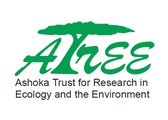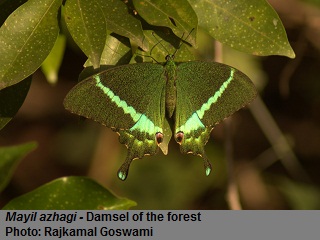Any and all opinions expressed in this newsletter are solely those of the author(s) and do not reflect the opinion of ATREE.
Centre for Excellence in Conservation Science
Royal Enclave,Srirampura,Jakkur Post
Bangalore-560064
Telephone: 080-23635555 (EPABX)
Fax : 080- 23530070
A social science researcher in a forest is
essentially working with people rather than
looking at plants and animals. Thus, personal
conduct, especially with young women,
becomes important if the researcher is male.
All this while during fieldwork I had kept in
mind Gandhi's advice to R.K. Narayan's
protagonist in Waiting for the Mahatma. This
was to the effect that in order to keep the
senses in control one should lower one's
eyes to the ground at the sight of an attractive
woman. This was always a source of
personal dejection. But this visit, I hoped,
would be different. Since I was supposed to
be observing plant-animal interactions
instead of asking pesky questions of people, I
felt I could be bolder.
Soon, however, I realised that ecology
fieldwork is a lonesome exercise. For the first
couple of days, the only women I saw were
my female course-mates and course
instructor. On the third day, I desperately
hoped to espy some demure belle bathing in
one of the forest streams. Determined to look looks, I felt like a martyr for a grand cause.
Tragically though, despite craning my neck
360-degrees all day along the forest trail, the
only thing I attracted was leeches in the
dozens. In the end, I rested content with the
picturesque butterflies in the KMTR field-
guide, many of whose local names ended in
azhagi (= beautiful woman). After prevaricating between Pon azhagi (Southern
Birdwing) and Mayil azhagi (Common
Banded Peacock), I eventually pledged my
loyalty to the grand-sounding Naattu neela
kannaadi azhagi (Common blue bottle) .
By this time, however, KMTR had me smitten.
The thick forests and limpid waters sat as
easily with the regimen of the tea plantations
as with the mythological distinction of the
Podhigai hills - the cradle of the Tamil
language and the legendary Tamirabarani
river. Academically, the trip was an occasion
for valuable disciplinary integration. I began
to recognise a different dimension of human
interactions with the natural world, one that I
had hitherto remained oblivious of. I can see
the transition occurring in my thought-
process, and hope it will reflect in the work
that I intend to do in the future.
I do hope to go back to KMTR again. For
plant-animal interactions and more. After all,
hope springs eternal in the human breast!
Editorial Team
Editor: Allwin Jesudasan
Associate editor: Rajkamal Goswami
Editorial Review: R. Ganesan, M. Soubadra Devy, T. Ganesh
Design and presentation: Kiran Salagame
A S H O K A T R U S T F O R R E S E A R C H I N E C O L O G Y A N D T H E E
N V I R O N M E N T
Tales from wilderness
A Renegade Anthropologist in the Podhigai Hills
- R. Venkat Ramanujam
If you have any suggestions or comments please let us know through the boxes below






